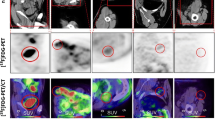Abstract
Purpose: To assess the potential value of magnetic resonance imaging (MRI) combined with67Ga single-photon emission computed tomography (SPECT) versus computed tomography (CT) in the staging and in the monitoring of mediastinal malignant lymphoma.
Materials and methods: Twenty-three patients, referred to our institute for the evaluation of lymphoma, underwent CT,67Ga scan, and MRI between April 1993 and February 1996 at sequential intervals. The tests studied (MRI,67Ga, and CT) were performed according to the following schedule: 1) before start of therapy; 2) after four courses of chemotherapy; and 3) 2, 6, 12, and 18 months after the end of treatment.
Results: All patients studied at the time of diagnosis had abnormal gallium accumulation in the mediastinum as well as pathologic CT and pathologic signal intensity at MRI. Six months after the end of treatment full consistency was found between the results of MRI and SPECT, whereas during treatment and 2 months after the end of therapy MRI and67Ga scan were not in agreement in nine patients. In the 23 patients in follow-up, in CT there were nine false-positive and three false-negative findings; in SPECT three false negatives; in MRI one false positive and one false negative.
Conclusion: MRI can give morphologic information similar to CT, even superior due to multiplanarity and with major precision in the distinction between fibrosis and active disease. MRI is thus an alternative to CT. The association with SPECT allows a great diagnostic accuracy in the positive and negative predictive value.
Similar content being viewed by others
References
Jochelson M, Mauch P, Balikian J,et al. (1985) The significance of the residual mediastinal mass in treated Hodgkin's disease. J Clin Oncol3: 634–640.
Radford JA, Cowan RA, Flanagan M,et al. (1988) The significance of residual mediastinal abnormality on the chest radiograph following treatment for Hodgkin's disease.J Clin Oncol 6: 940–946.
Higgins CB, Hricak H, Helms CA (1990) Role of MRI in the staging of thoracic lymphoma. In Higgins, ed.Magnetic Resonance Imaging of the Body. pp. 484–489. New York: Raven Press.
Lewis E, Bernardino ME, Salvator PG,et al. (1982) Post therapy CT detected mass in lymphoma patients. It is a viable tissue?J Comput Assist Tomogr 6: 792–796.
Nyman R, Rehn SM, Glimelius BLG,et al. (1989) Residual mediastinal masses in Hodgkin's disease: prediction of size with MR imaging.Radiology 170: 435–440.
Skillings JR, Bramwell V, Nicholson RL,et al. (1991) A prospective study of magnetic resonance imaging in lymphoma staging.Cancer 67: 1838–1843.
Nyman R, Rehn SM, Glimelius BLG,et al. (1987) Magnetic resonance imaging for assessment of treatment effects in mediastinal Hodgkin's disease.Acta Radiol 28: 145–151.
Glazer SH, Lee JKT, Levit RG (1985) Radiation fibriosis: differentiation from recurrent tumor by MR imaging.Radiology 156: 721–726.
Front D, Ben-Haim S, Israel O,et al. (1992) Lymphoma: predictive value of Ga-67 scintigraphy after treatment.Radiology 182: 359–363.
Drossman SR, Schiff RG, Kronfeld GD,et al. (1990) Lymphoma of the mediastinum and neck: evaluation with Ga-67 imaging and CT correlation.Radiology 174: 171–175.
Bekerman C, Hoffer PB, Bitran JD (1985) The role of Ga-67 in the clinical evaluation of cancer.Sent Nucl Med 14: 296–303.
Israel O, Front D, Lam M (1988) 67-Gallium imaging in monitoring lymphoma response to treatment.Cancer 61: 2439–2443.
Kaplan WD, Jochelson M, Herman T (1988) 67-Gallium imaging: a predictor of residual tumor viability in patients with diffuse large cell lymphoma (abstract).J Clin Oncol 6: 230.
Gasparini MD, Balzarini L, Castellani MR,et al. (1993) Current role of gallium scan and magnetic resonance imaging in the management of mediastinal Hodgkin lymphoma.Cancer 72: 577–582.
Andersen KC, Leonard RCF, Canellos GP,et al. (1983) High dose gallium imaging in lymphoma.Am J Med 75: 327–331.
Heshiki A, Schatz S, Me Kusick,et al. (1974) Gallium-67 scanning in patients with pulmonary sarcoidis.Am J Roentgenol 122: 744–749.
Rahmouni A, Zerhouni EA (1990) Role of MRI in the management of thoracic lymphoma. In: Zerhouni EA, ed. CT and MRI of the Thorax, pp. 23–35. New York: Churchill Livingstone.
Rahmouni A, Tempany C, Jones R,et al. (1993) Lymphoma: monitoring tumor size and signal intensity with MR imaging.Radiology 188: 445–451.
Foss Abrahamsen A, Lien HH, Aas M,et al. (1994) Magnetic resonance imaging and 67-gallium scan in mediastinal malignant lymphoma: a prospective pilot study.Ann Oncol 5: 433–436.
Castellino RA (1986) Hodgkin disease: practical concepts for the diagnostic radiologist.Radiology 159: 305–310.
Castellino RA (1991) Non-Hodgkin lymphomas: practical concepts for the diagnostic radiologist.Radiology 178: 315–321.
Brice P, Rain JD, Frija J,et al. (1993) Residual mediastinal mass in malignant lymphoma: value of magnetic resonance imaging and 67-gallium scan.Nouv Rev Fr Hematol 35: 457–461.
Rehn SM, Nyman RS, Glimelius BLG,et al. (1990) Non-Hodgkin lymphoma: predicting prognostic grade with MR imaging.Radiology 176: 249–253.
Front D, Bar-Shalom R, Epelbaum R,et al. (1993) Early detection of lymphoma recurrence with 67-gallium scintigraphy.J Nucl Med 34: 2101–2104.
Hoane BR, Shields AF, Porter BA,et al. (1994) Comparison of initial lymphoma staging using computed tomography (CT) and magnetic resonance imaging (MRI).Am Hematol 47: 100–105.
North LB, Fuller LM, Sullivan Halley JA,et al. (1987) Regression of mediastinal Hodgkin disease after therapy: evaluation of time interval.Radiology 164: 599–602.
Olson EM, Colleen JB, King MA (1995) Fast SE MRI of the chest: parameter optimization and comparison with conventional SE imaging.J Comput Assist Tomogr 19: 167–175.
Smith RC, Constable RT, Reinhold C (1994) Fast spin echo STIR imaging.J Comput Assist Tomogr 18: 209–213.
Canini R, Battista G, Monetti N,et al. (1995) Bulky mediastinal lymphomas: role of magnetic resonance and SPECT-Ga-67 in the evaluation of residual masses.Radiol Med 90: 448–456.
Author information
Authors and Affiliations
Rights and permissions
About this article
Cite this article
Bendini, M., Zuiani, C., Bazzocchi, M. et al. Magnetic resonance imaging and67ga scan versus computed tomography in the staging and in the monitoring of mediastinal malignant lymphoma: a prospective pilot study. MAGMA 4, 213–224 (1996). https://doi.org/10.1007/BF01772009
Received:
Accepted:
Issue Date:
DOI: https://doi.org/10.1007/BF01772009




